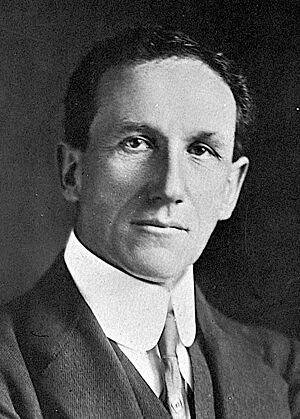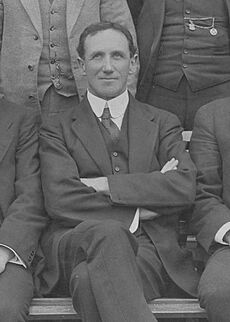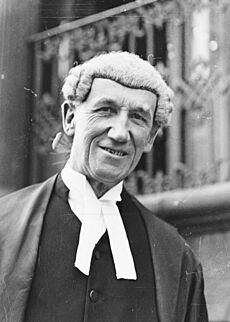William Holman facts for kids
Quick facts for kids
William Holman
|
|
|---|---|
 |
|
| 19th Premier of New South Wales | |
| In office 30 June 1913 – 12 April 1920 |
|
| Monarch | George V |
| Governor | Sir Gerald Strickland Sir Walter Davidson |
| Preceded by | James McGowen |
| Succeeded by | John Storey |
| Attorney-General of New South Wales | |
| In office 21 October 1910 – 29 January 1914 |
|
| Premier | James McGowen |
| Preceded by | Charles Wade |
| Succeeded by | David Hall |
| Member of the Australian Parliament for Martin |
|
| In office 19 December 1931 – 5 June 1934 |
|
| Preceded by | John Eldridge |
| Succeeded by | William McCall |
| Member of the New South Wales Legislative Assembly | |
| In office 27 July 1898 – 18 February 1920 |
|
| Constituency | Cootamundra (1904–1920) Grenfell (1898–1904) |
| Personal details | |
| Born | 4 August 1871 St Pancras, London, England |
| Died | 5 June 1934 (aged 62) Gordon, New South Wales, Australia |
| Political party | Labor (until 1916) Nationalist (1916–1931) UAP (after 1931) |
| Spouse |
Ada Kidgell
(m. 1901) |
| Relations | Portia Holman (daughter) |
| Occupation | Cabinet-maker, trade union official, journalist |
William Arthur Holman (born August 4, 1871 – died June 5, 1934) was an important Australian politician. He served as the Premier of New South Wales from 1913 to 1920. The Premier is like the leader of the state government.
He first became Premier as the head of the Labor Party. However, he was later removed from the party in 1916 due to a big disagreement. After this, he helped create and became the first leader of the New South Wales branch of the Nationalist Party.
Holman was born in London and moved to Australia when he was 17. He became a cabinet-maker in Sydney. Before becoming a politician, he was active in the labour movement. He worked as a journalist and a union official, helping workers.
He was elected to the New South Wales Legislative Assembly in 1898. This is the main law-making body for the state. He also studied law and became a lawyer in 1903. In 1910, Holman became the Attorney-General of New South Wales. This is the chief legal advisor for the state government. He served in the first Labor government, led by Premier James McGowen.
Holman took over from McGowen as Premier in June 1913. Later that year, he led his party to win the state election.
In 1916, a major debate happened about whether Australia should force people to join the army for overseas service (called conscription). Holman supported this idea, which caused a big split in the Labor Party. He was then expelled from the party.
Holman and his supporters stayed in government with help from the opposition Liberal Reform Party. These two groups later joined together to form the new Nationalist Party in New South Wales. Holman became its leader. The new party won a large victory in the 1917 election.
However, the Nationalist Party lost badly in the 1920 election. Holman even lost his own seat in parliament. After this defeat, he went back to working as a lawyer. He was later elected to the Australian House of Representatives in 1931. This is part of the national parliament. He was not in good health and died before finishing his first term.
Contents
Early Life and Moving to Australia
William Holman was born in St Pancras, London, England in 1871. His father was an actor, and his mother was also involved in theatre.
He went to an Anglican school and learned to be a cabinetmaker. He also took night classes and joined groups where people discussed books and ideas.
Holman believed his love for learning came from his teacher, Matilda Sharpe. She taught Latin to many students at once. In the 1880s, times were tough for theatre in Britain. So, Holman's family moved to Melbourne, Victoria, Australia, in October 1888 for acting jobs.
After a theatre in Melbourne burned down in 1889, his family moved to Sydney, New South Wales.
Working for Workers' Rights
As a cabinetmaker in Sydney, Holman became very interested in ideas about society and fairness. He joined several groups that worked for social change and workers' rights. He was part of the Australian labour movement.
He joined the Labor Electoral League, which was an early version of the Australian Labor Party (ALP). In another group, the Australian Socialist League, he met other important figures like future Prime Minister Billy Hughes.
In 1893, Holman became the Secretary of the Railways and Tramways Employees' Union. He represented this union on the Sydney Trades and Labor Council. He tried to get elected to the New South Wales Legislative Assembly in 1894 and 1895 but was not successful at first.
From 1896 to 1898, he worked as an organiser for the Australian Workers' Union. This union helped workers across Australia.
Becoming a Lawyer
In 1900, Holman started studying law part-time. In 1903, he passed his exams and became a barrister. A barrister is a type of lawyer who represents people in court.
Later, in the 1920s, when he returned to his legal work, he was made a King's Counsel. This is a special title given to experienced lawyers.
Political Career in New South Wales
In the late 1890s, Holman was a key member of the early Labor Party. He was elected as a Member of Parliament for Grenfell in the New South Wales Legislative Assembly in 1898.
When the Grenfell area changed in 1904, Holman moved to represent the new area of Cootamundra. He became the deputy leader of the Labor Party in 1905.
In 1910, the Labor Party won the government in New South Wales for the first time. James McGowen became Premier, and Holman was made the Attorney General.
Premier of New South Wales: Leading the State
On June 30, 1913, James McGowen resigned, and William Holman became the leader of the New South Wales Labor Party. This made him the Premier of the state.
During his time as Premier, many state-owned businesses were created. These businesses were set up to compete with private companies. This was a way to achieve some of the Labor Party's goals.
One challenge was that the Labor Party wanted to get rid of the New South Wales Legislative Council, which is like an upper house of parliament. Many of the government's proposed laws were not passed by this upper house.
The Conscription Debate and Party Change
In 1916, a big issue divided the Labor Party and the whole country: conscription for overseas military service. Conscription means forcing people to join the army.
Many people in the Australian labour movement and the public were against conscription. However, Holman strongly supported it, just like the national Prime Minister, Billy Hughes. Because of his support for conscription, both Holman and Hughes were removed from the Labor Party.
On November 15, 1916, Holman and 17 other Labor Members of Parliament who supported conscription formed a new group. They joined with the opposition Liberal Reform Party. Holman remained Premier.
In early 1917, Holman and his supporters officially merged with the Liberal Reform Party. They formed the state branch of the new Nationalist Party. Even though many members of the new party were from the old Liberal Reform Party, Holman was chosen as the leader. This meant he continued as Premier.
At the state election in March 1917, the Nationalists won a huge victory. This showed how much support they had.
Holman worked hard to protect the state-owned businesses he had helped create when he was with the Labor Party. However, at the state election on March 13, 1920, Holman and his Nationalists lost power. A Labor government, led by John Storey, took over. Holman even lost his own seat in parliament, which is unusual for a Premier.
Later Life and Death
After leaving state politics, Holman was elected to the federal parliament. He represented the Sydney area of Martin in December 1931. He was a member of the United Australia Party, which had taken over from the Nationalists.
He served as a regular Member of Parliament in the government led by Joseph Lyons. Holman's health had been getting worse for several years. He died on June 5, 1934, in Gordon, a suburb of Sydney, due to health problems. He was cremated the next day.
Personal Life
On January 22, 1901, William Holman married Ada Augusta Kidgell. She was a journalist and writer.
They had one child, a daughter named Portia Holman, born in 1903. Portia later became a doctor in England.
In 1934, a painting of Holman by John Longstaff won a famous art prize called the Archibald Prize.
Images for kids






